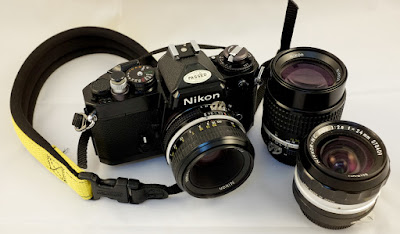A few weeks ago, while I was off on holiday break, I had some time to go through some of the "shoeboxes" of film shot back in 2000-2002. Four boxes of 4x6 (mostly) color prints and negatives that for the most part, have sat there, and have not been scanned or shared. As I went through them, I realized how much better a photographer I am now than back then. Some sets of tossed in the trash as there were no images really worth saving. In 1999-2000, I was starting anew with a passion for photography, learning as much as I could, using better cameras, and hopefully better technique. I shot a lot on color print film, and did not start developing my own b&w until 2001. Even so, I shot a lot of images that are just crappy by my current standards. Lack of good focus, subject position, bad lighting, uninteresting images, etc. I am sure at the time, I thought some of them were okay. However, I was learning by shooting. Color film was fairly inexpensive and so was processing at the local stores. One thing is for sure, some of the images were better after I scanned them in and adjusted them to my preferences. Overall though, I was learning to "see," to compose, and eventually, after many years I am a much more sophisticated photographer. Compare this to being a musician, and it's similar. Same for any art form. We improve by doing. Until we actually practice, we don't improve. Whether its shooting every day, drawing every day, playing every day, we improve over time. We develop a more sophisticated ear, a better vision of our end product, and our imagination is able to produce something because we have taken control of the tools, improved our education about our craft, and have made our tools an extension of our talent.
Of course, one can say that it's easier with digital. It's just easier to take shitty banal images and fill up a hard drive with them. The envelopes of 4x6 prints remind me of where I was, and how much better I am now. I have a better grasp of aesthetics, moods, composition, and so much more than I did 15 years ago. I should be happy with that, but I know that I can still be better. That's part of being an artist of any sort. Complacency leads to mediocrity. Always test yourself in some way-- find new challenges, new projects, new techniques. THE CAMERA DOES NOT MATTER. It's the gray matter between your ears that will make you a better photographer. The limitations that you set for yourself are your barriers. I know this to be true, and not some phrase plucked from the internet.
What do you want to do with your photography? Why are you not doing it? List the things that keep you back, and address them. Fear is the biggest reason for many of us. Fear of how people will react, fear of the unknown, fear of failure. You have to learn by doing. Do it until you get over your fears, and you will see improvement.
I'm 59 now, and I wish I had worked harder on photography while in my 20s-30s, I had to eventually get serious about photography in my 40s. In knowing what I know now, I missed a lot of opportunities to document changes that have taken place. My interpretation of changes, anyways.
Back to the boxes of photographs. I'll winnow those down, keeping the images that depict family, friends, significant events or places. A lot of the nature images are crappy stuff. They served the purpose of learning what I needed to, and if they are not good enough to keep, into the trash they go.
Taken in 2002, with a Contax G1 on Ilford XP-2. My daughter with her Nikon FG and 80-300 zoom. She was between middle and high school. This one is a keeper, of course.
















